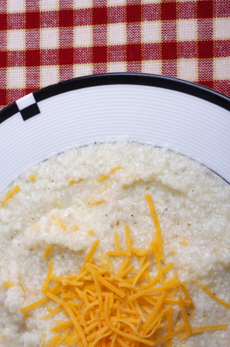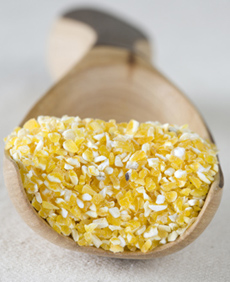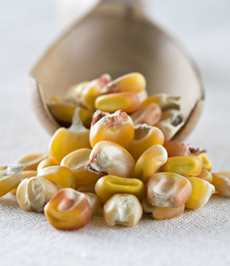 Made with your favorite cheese, cheese grits are comfort food. Photo by N. Redmond | IST. Made with your favorite cheese, cheese grits are comfort food. Photo by N. Redmond | IST.
|
KAREN HOCHMAN is Editorial Director of THE NIBBLE.
|
|
March 2011
Last Updated September 2018 |
 |
Cheese Grits Recipe
Cheese Grits or Cheesy Grits, They’re Delicious
Cheese Grits (Or Cheesy Grits) Introduction
First made by Native Americans, grits are an ubiquitous menu item in the American South. The area from Virginia to Texas is even called the “Grits Belt,” where grits are served for breakfast, lunch and dinner (and that sounds great to us!).
Grits are the hard part of the corn kernel (the endosperm), cut into uniform small pieces. They are related to polenta, which is made from a different type of corn and is usually a finer grind. Another related product, farina, known in the U.S. as cream of wheat, is made from semolina flour.
For the record, corn is classified by the type of starch in its kernels. Dent corn, the premier corn in the South, has a relatively soft, starchy center that makes the best grits. Flint corn, used for polenta, has a hard, starchy endosperm and produces a more granular cornmeal with a better texture (mouthfeel).
Grits are available in white and yellow varieties, as well as mixed white and yellow. White corn has more earthy and floral flavors than yellow corn, which offers a note of citrus along with more robust corn flavor. Yellow grits add more color to the plate.
Hominy grits, which are cooked in an alkaline solution before grinding, add a flavor nuance that many people find attractive. Tortillas, tamales and corn chips are made with this process, which is called nixtamalization.
Eating Your Grits
As with oatmeal and other cereals, you can find a wide range of grits, from slow-cooked to instant. Enjoy grits:
- As a bowl of porridge with butter, milk and sugar (or syrup, honey or jam).
- With eggs, bacon and/or sausage
- As a side (instead of potatoes, rice or other grains) with ham and seafood (shrimp and grits is a popular combination): plain, with butter or gravy
- As part of a vegan meal, with grilled vegetables or a Middle Eastern salad (chopped tomatoes, green peppers and onions in a light vinaigrette—we add fresh herbs and substitute lemon juice for half the vinegar)
- As a comfort food snack—cheese grits are our favorite here
No matter what the time of day, we love cheese grits. While most people use grated cheddar, we prefer Parmesan. You might enjoy Emmenthaler or other Swiss cheese, or a combination of cheeses. Feel free to combine the remnants of last night’s cheese board.
Cheese Grits Recipe
- CONSIDER the liquid. We use water, but you can use milk for a richer, creamier porridge; or add a teaspoon of butter per serving.
- COOK the grits according to package directions. (You can also bake the cheese grits, adding some browned garlic and hot sauce.) As the cooking nears completion...
- ADD the shredded or grated cheese(s) of your choice. How much cheese depends on how cheesy you like things. You can always stir in more cheese at the table.
- STIR the grits and cheese together. If you’re using instant grits, stir the cheese in upon removing from the microwave.
- FINISH with fresh-cracked pepper.
Splurge and try the stone-ground grits from Anson Mills or Charleston Favorites. They are so worth it!
A Brief Grits Vocabulary
GRIST: Everything that comes out of a stone mill when milling grain.
GRITS or HOMINY GRITS: The hard part of the corn kernel (endosperm), cut into uniform small pieces, about 1/16th to 1/20th of an inch across, and separated from the corn meal, corn flour, corn germ and hull. Hominy grits are another form of hominy, produced by grinding the dried and processed corn kernels several times into a finer grained substance to be sold as fine, medium, or coarse textured hominy. Grits are often combined with milk and water and traditionally served in the southern U.S. as pudding, as a side dish, or made into squares and fried. Historically, white corn was popular in the urban port cultures of the South (Wilmington, Charleston, Savannah, New Orleans) that were settled by Europeans with a predilection for white mill goods. Moving inland through the rural American South, yellow corn and grits predominated. |
|

Anson Mills antebellum coarse yellow grits.
|
White corn possesses more pronounced mineral and floral nuances; yellow corn is more robust with citrus flavor at the back of the palate.
HOMINY: A food made by soaking whole corn in slaked lime solution to remove the germ and hull. A corn product that is created by soaking white or yellow corn kernels in scalding water mixed with a chemical solution, such as a mild lye or slaked lime. The soaking forces the kernel to expand so the hull and germ split. This allows the kernel to be easily removed so that the remaining corn substance can be dried. After it has been dried, the whole kernels are soaked in water and a solution mixed with limestone or wood ash to expand the kernels, which are then boiled, creating a soft puffy food product. |
|

Anson Mills Henry Moore hominy corn. |
Hominy is the Colonial English spelling of the sound of the oral Native American word for corn. Charlestonians have always called fresh whole ground corn grits “hominy,” a shortened version of the old Carolina term for whole corn “hominy grist.”
Lifestyle Direct, Inc. All rights reserved. Images are the copyright of their respective owners.

|




 Made with your favorite cheese, cheese grits are comfort food. Photo by N. Redmond | IST.
Made with your favorite cheese, cheese grits are comfort food. Photo by N. Redmond | IST.
